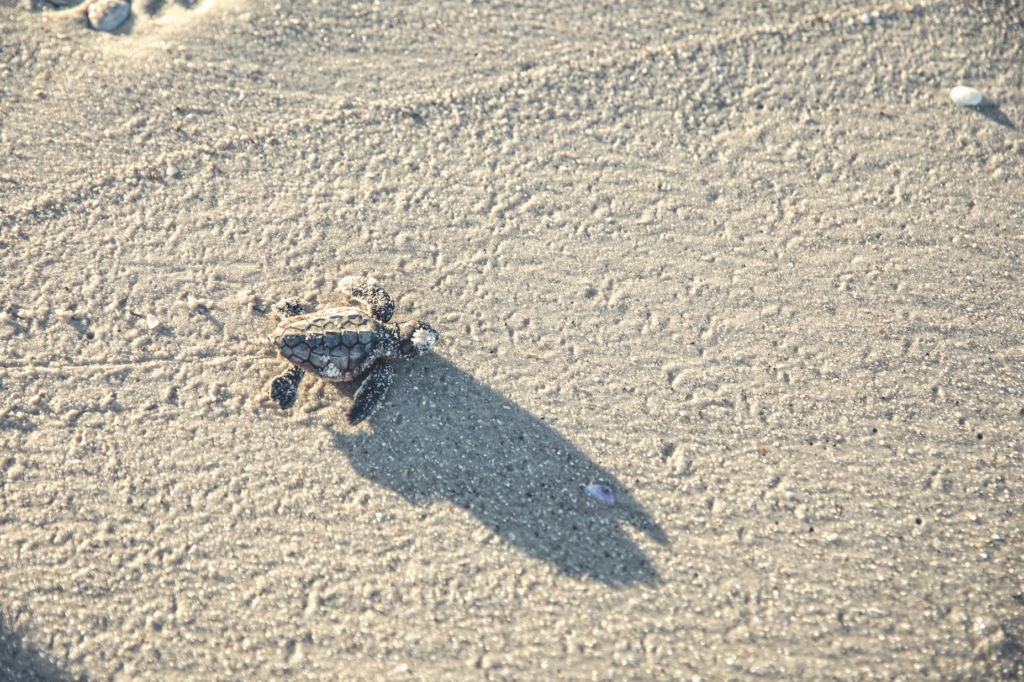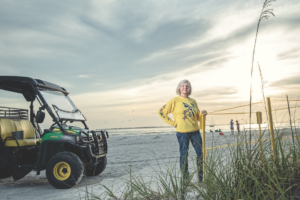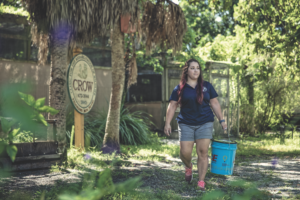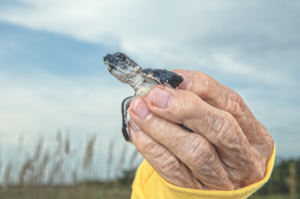 Sea turtles once filled the waters off the beaches of Sanibel, Fort Myers Beach, Bonita Beach and Marco Island. The Gulf was home to vast numbers of loggerheads, greens, Kemp’s ridleys, hawksbills and leatherbacks. Yet as the state was settled, those numbers dramatically decreased. Sea turtles were hunted for their meat and eggs, and they fell victim to trawling shrimp boats. Gulf pollution also took its toll. The most recent red tide outbreak was responsible for the death of nearly 600 sea turtles.
Sea turtles once filled the waters off the beaches of Sanibel, Fort Myers Beach, Bonita Beach and Marco Island. The Gulf was home to vast numbers of loggerheads, greens, Kemp’s ridleys, hawksbills and leatherbacks. Yet as the state was settled, those numbers dramatically decreased. Sea turtles were hunted for their meat and eggs, and they fell victim to trawling shrimp boats. Gulf pollution also took its toll. The most recent red tide outbreak was responsible for the death of nearly 600 sea turtles.
But through the dedicated efforts of environmentalists, biologists, wildlife veterinarians, clinicians and hundreds of volunteers, local sea turtles are on the rebound. Already this year, Fort Myers Beach has seen a record number of sea turtle nests, putting it on track to have more nests than any other year to date. It’s an astounding victory for those who are committed to saving this vulnerable species.
With sea turtle season, coming to an end, we honor four local heroes who have brought sea turtles back from the brink.
The Scientist
Maura Kraus is easy to spot. She’s the woman riding her all-terrain vehicle on Naples beach first thing each morning. When she stops to check on a turtle nest, she usually has a following. “Little kids love to watch,” Kraus says. “Sometimes there’s a baby left in the nest, or if I’m opening up the unhatched eggs, they like to see the embryos.” She’s happy to slip into professor mode and explain the different stages of sea turtle development.
Trained as a marine biologist at the University of Miami, and with a graduate degree in Coastal Zone Management from Nova Southeastern University, Kraus has been using her scientific mind to save sea turtles for almost 40 years. She grew up in Fort Lauderdale, where the beach was her playground, and fell in love with marine biology in high school. She began monitoring sea turtle nests on Keewaydin Island for the Conservancy soon after she completed her graduate studies, and eventually she was hired by the county. Today she’s the principal environmental specialist for Collier County, and she’s in charge of the county’s sea turtle protection program.
Over the years, Kraus has been involved in some of the most important sea turtle conservation efforts in Southwest Florida. In 1989, she helped write the first beach lighting ordinance for Collier County, which mandated that beachfront property owners turn off their outside lights during turtle nesting season. She also played an instrumental role in the beach renourishment programs on Naples Beach and Marco Island.
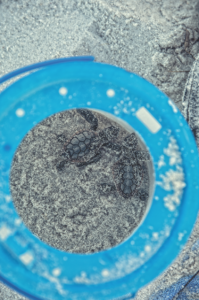 Today, Kraus continues to monitor sea turtle nests seven days a week. She stakes new nests, digs up recently hatched ones to count the eggs, and performs postmortems on those that didn’t hatch. With hatchlings who can’t make their way out, she either helps guide them to the ocean or takes them to be rehabilitated, being mindful to avoid human contact with the turtles, as much as possible.
Today, Kraus continues to monitor sea turtle nests seven days a week. She stakes new nests, digs up recently hatched ones to count the eggs, and performs postmortems on those that didn’t hatch. With hatchlings who can’t make their way out, she either helps guide them to the ocean or takes them to be rehabilitated, being mindful to avoid human contact with the turtles, as much as possible.
All of this information she records in an extensive database that has been invaluable in documenting progress. “The sea turtle community knew it would take a long time to see results,” Kraus says. “With long-lived reptiles like loggerheads, it takes 30 to 35 years to reach maturity. And only one in every thousand makes it.”
Kraus and her colleagues had a clear aha! moment in 2016 when they found themselves suddenly covered up with nests. “It was like, oh my God, where did all the turtles come from?” she says. The answer: they came from the combined labors of the turtle conservation community.
Kraus’ efforts don’t just benefit our area. Sea turtles are a global species that follow a transoceanic migratory pattern. They come to our shores to nest once a year or once every couple of years. The rest of the time they might be swimming in the warm waters off the Bahamas or Cuba, or they could be farther north in the Gulf of Mexico. Wherever sea turtles go, they serve an essential function in the environment. Green sea turtles, for example, keep the sea grasses in check. Kraus calls them “little lawnmowers of the sea.” Loggerheads and Kemp’s ridleys help maintain the crab population. Each has its own niche. “They’ve been doing this for hundreds of millions of years,” Kraus says. “That’s why it’s important to keep them in the ecosystem.
The Protector
When Eve Haverfield launched Turtle Time in 1989, she was a one-woman operation. She’d start on Fort Myers Beach at sunup and cruise the length of the island on her three-wheeler, looking for new sea turtle nests that had been laid overnight. When she’d finish, she’d load the three-wheeler into the back of her truck and head to Lovers Key State Park. Then Bonita Beach.
Now, 31 years later, Haverfield oversees a corps of nearly 200 volunteers who monitor the coastline from the northern tip of Fort Myers Beach to the Lee-Collier border of Bonita Beach, plus Bunche Beach. And Turtle Time, Inc. has become the most powerful sea turtle-protection group in the region. “It’s not power, it’s persuasion,” Haverfield corrects. “I try to be as diplomatic and persuasive as possible. I don’t want to make enemies for sea turtles. What’s good for sea turtles is good for people, too.”
Turtle Time’s handiwork is evident up and down Lee County’s beaches. Members cruise the coast looking for nests, and block them off with wooden stakes, yellow tape and signs alerting visitors to the presence of the federally protected nests. Turtle Time is also behind some of the most important sea turtle-protection initiatives on the beach, like getting homeowners to turn off outdoor lights during nesting season. Hatchlings use the moon’s light to guide them toward the Gulf, and man-made lights can disorient baby turtles, luring them inland. There, they perish on roadways or are eaten by predators. Homeowners who violate the lighting ordinance on Fort Myers Beach face a fine of up to $500 per day. And if a house’s lights are responsible for a “disorientation event”—where hatchlings are found to have died because they followed a light away from the sea—then the owner could be in violation of state and federal laws and face thousands of dollars in fines. “This isn’t some little hobby of mine,” Haverfield says. “These turtles are protected under the Endangered Species Act.”
 While these initiatives have dramatically reduced the number of hatchling deaths, they’ve raised the ire of some local property owners. But Haverfield isn’t worried. “At times we do have to be firm,” she says. “We have to stand by our convictions.”
While these initiatives have dramatically reduced the number of hatchling deaths, they’ve raised the ire of some local property owners. But Haverfield isn’t worried. “At times we do have to be firm,” she says. “We have to stand by our convictions.”
Haverfield has a background in nursing and mental health, and she’s been fascinated by sea turtles since she first spotted a pair of tracks on Sanibel in the 1970s. Her days are still busy—she visits the beach every morning, especially during the nesting months—but fighting to protect these vulnerable creatures hasn’t lost its charm. “Every year is different,” she says.
And her efforts have paid off. The number of local nests has shown a steady rise, from 30 nests in 1996, the first year of available data, to 112 nests in 2019. This year has already seen an incredible uptick in nest numbers on Fort Myers Beach, and 2020 is on track to have more nests than any year documented so far. With roughly 100 eggs per nest, that means a lot more baby sea turtles in the world.
Haverfield has a theory for the reason behind this dramatic increase. Loggerheads—the most common sea turtle along the Gulf Coast, and the source of most of the nests on Fort Myers Beach—take 30 to 50 years to reach maturity. Because loggerheads will return to the same spot where they hatched to lay their eggs, it’s likely that this summer’s nests are the offspring of the hatchlings Haverfield first worked to save when she started Turtle Time 30 years ago. “It takes a village,” she says. “And all of us are committed to making a difference.”
The Ambulance Driver
Tim Thompson has been around sea turtles most of his life. He grew up on Florida’s east coast, a block from the Atlantic Ocean. “Over there, when you wake up in the morning during the peak of turtle season, every 30 yards is a nest,” he says. When baby hatchlings would dig their way to the surface, he and his friends would chase off swarming gulls. “We’d be late for school, but they’d excuse us for helping save baby sea turtles,” he recalls.
That initial enchantment has stayed with Thompson. “When you grow up close to the ocean, it’s in your blood,” he says. Now 61, Thompson owns Malibu West Interiors in Naples with his wife, Leslie. Because he travels to job sites from Marco Island to Sanibel, being on the road has opened up an unusual volunteer opportunity: He serves as a sea turtle ambulance driver for wildlife rehabilitation centers across both counties.
In 2006, Thompson signed up as a volunteer Critter Courier with the Conservancy of Southwest Florida, and today he’s one of the group’s go-to drivers for injured sea turtles. He’s also driven for the Clinic for the Rehabilitation of Wildlife (CROW), Rookery Bay and FWC’s Marine Fisheries. When he gets an urgent call, Thompson rushes to the pickup site and loads the injured turtle into the covered bed of his Ford Ranger. He drapes the turtle in wet towels, then sets off for the wildlife hospital that placed the call. Though he’s seen all varieties of sea turtles in his nearly 15 years of volunteering, one has stayed with him—a Kemp’s ridley suffering from brevetoxicosis, from the marine neurotoxin caused by red tide.
 On this particular day, he didn’t have his truck, but the turtle was small enough to fit inside a box and slide into the back seat of the family sedan. He remembers its labored breathing, soft and shallow. “Like a baby’s breath,” he says. He remembers the smell. “Like things we love—seashells, the ocean.” He remembers arriving at the von Arx Wildlife Hospital, where the veterinary team put the turtle on a stretcher. Thompson was ushered out—his job was finished—but through the closed door he could hear the sound of the turtle’s heart beating over an ultrasound.
On this particular day, he didn’t have his truck, but the turtle was small enough to fit inside a box and slide into the back seat of the family sedan. He remembers its labored breathing, soft and shallow. “Like a baby’s breath,” he says. He remembers the smell. “Like things we love—seashells, the ocean.” He remembers arriving at the von Arx Wildlife Hospital, where the veterinary team put the turtle on a stretcher. Thompson was ushered out—his job was finished—but through the closed door he could hear the sound of the turtle’s heart beating over an ultrasound.
Thompson’s early years beside the sea imprinted him with a life-long affinity for its creatures and a desire to help one of its most vulnerable species survive. After all, he says, humans and sea turtles aren’t that different: “Just different beings.”
The Healer
For Breanna Frankel, the 28-year-old rehabilitation manager at CROW on Sanibel, every injured sea turtle that comes to the wildlife hospital is a puzzle. She’s always trying to figure them out—how to get them to eat, how to reduce their stress and how best to help them heal. “We’ve got to preserve as many of this species as we can,” she says.
Her job begins when an injured turtle arrives at CROW. Some have been hit by boats and some have swallowed fish hooks. Some were attacked by sharks and some suffer from the effects of red tide. The intake team moves the turtle to the second floor of the medical building, where the animal is weighed and receives a physical exam. They check for blindness and cataracts, look for signs of neurological trouble and draw blood. If there’s trauma to the turtle’s shell, then they take X-rays and inspect for lung damage. Fractured shells often equal trauma to the lungs. From there, CROW’s veterinarians create a treatment plan for the injured turtle, before the creature is handed over to Frankel.
Injured sea turtles can remain at CROW for weeks, even months. Compared to birds and mammals, sea turtles have a prolonged healing rate. “With sea turtles, just like with other reptiles, everything goes very, very slowly,” Frankel says.
While the turtles are rehabbing, she comes to know them well. She checks on them multiple times each day, noting their favorite foods—squid, sometimes, or live crabs—and observing whether they swim or rest on the bottom of their tanks. She pays special attention to the waterfall feature in each tank, where the turtles like to float and let the falling water run over their shells. “The sad turtles won’t use it,” she says. “The happy turtles that are rehabbing will love it.”
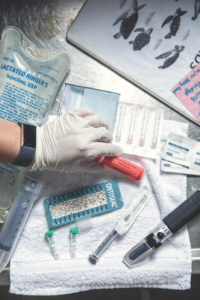 Despite this close observation, she’s careful to keep her distance. And she’s strict with her team: no talking or cell phones around the turtles; only staff members and the volunteers who clean the tanks allowed in the turtle barn. “The success of wildlife rehabilitation is based on the animal not habituating to humans,” she says. “If we show up in front of a sea turtle tank every day with food, then the animal becomes reliant on people.”
Despite this close observation, she’s careful to keep her distance. And she’s strict with her team: no talking or cell phones around the turtles; only staff members and the volunteers who clean the tanks allowed in the turtle barn. “The success of wildlife rehabilitation is based on the animal not habituating to humans,” she says. “If we show up in front of a sea turtle tank every day with food, then the animal becomes reliant on people.”
Frankel was once on a pre-med track in college. “But halfway through, I realized I didn’t like people,” she says. What she did like—what she loved, in fact—was animals. When she studied abroad in South Africa and had the chance to work on a game preserve, her path was set.
She’s been at CROW for five years, and during that time she’s seen more than 400 sea turtles come through the rehab center. She remembers many of their faces. “Some of them will look at me with eyes like they’ve just given up. They don’t want to surface. They don’t want to eat. Then one day they take a bite of food, and it’s like a light clicks and everything changes. They go from not swimming to swimming in circles. They go from not eating to eating every day.” She’s been known to let out a few excited yips the first time an injured turtle eats. “It can be very emotional,” she says.
Over time, many of the injured turtles that come to CROW get better. They put on weight. They swim. They enjoy the waterfall. And then one day, if everything goes well, they get released, healthy and healed, back into the sea from which they came.
Photography by Zach Stovall

